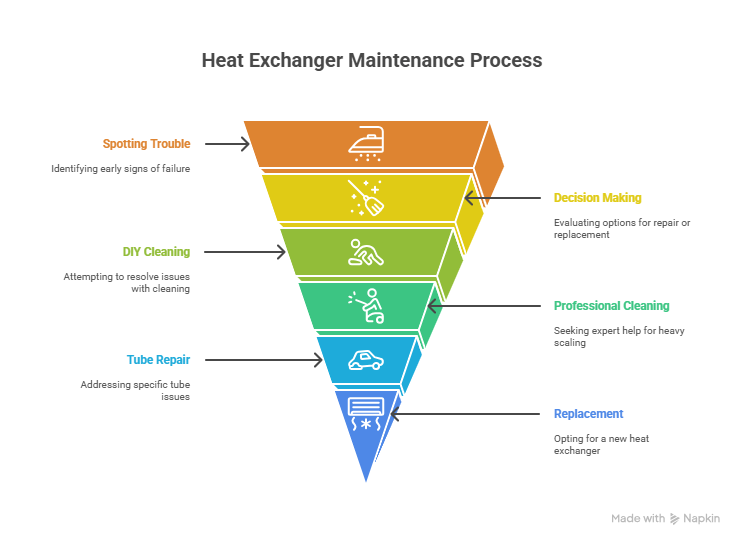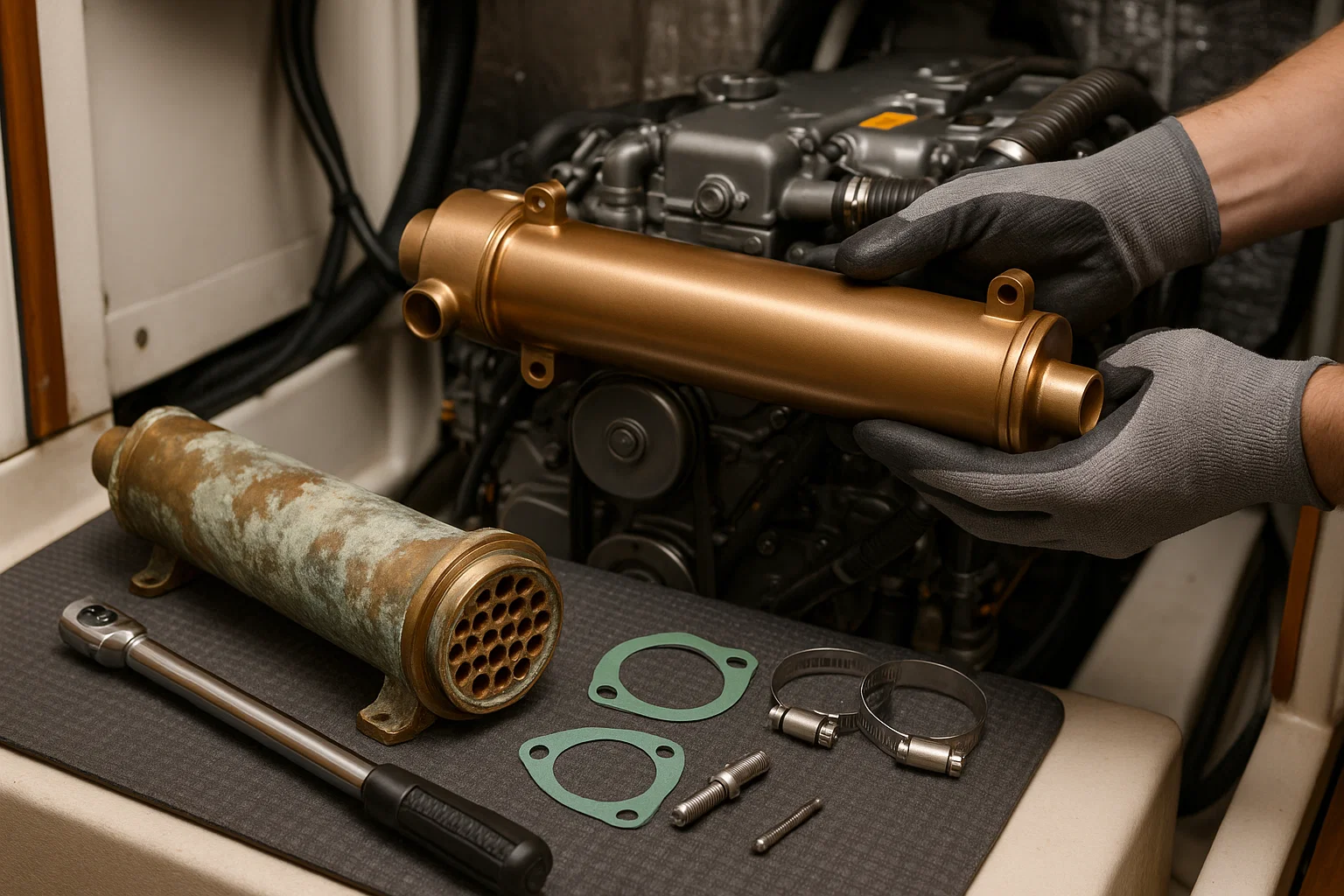The Overheating Sea Ray at Bahia Mar
A few years ago, a guy named Ray with a beautiful Sea Ray 340 called me in a panic. He was chugging back into Bahia Mar, and his engine temp gauge was pinned in the red. Steam was starting to puff from the engine hatch. Classic overheating. When I got there, the engine was scorching hot. The culprit? A completely clogged heat exchanger. It was packed solid with salt scale and bits of an old impeller.
That little metal box is the heart of your engine’s cooling system. It’s the only thing standing between a smooth day on the water and a catastrophic engine meltdown. A lot of boat owners don’t even think about it until it’s too late. That’s why understanding how to service it—and when to consider a full boat heat exchanger replacement—is one of the most critical skills you can have.
So, let me walk you through this like we’re standing on the dock. No jargon, just real-world advice from someone who’s seen it all.
Table of Contents
What This Thing Actually Does (And Why It Matters)
Think of the heat exchanger like the radiator in your truck. Your engine has a closed loop of coolant (antifreeze) running through it to pick up heat. But instead of using air to cool that liquid, it uses raw seawater.
Inside the heat exchanger, there’s a bundle of little tubes. The hot engine coolant flows through the tubes, while cooler seawater is pumped around them. The heat jumps from the coolant to the seawater, and that seawater gets spit out your exhaust. It’s a genius setup because it keeps corrosive salt water out of your engine block.
When this system works, your engine is happy. When it doesn’t, you get that panicked call like the one I got from Ray. A failed heat exchanger is a direct path to major engine damage.

Spotting Trouble: The Ugly Signs Your Heat Exchanger is Dying
Your engine usually gives you warnings before it totally gives up the ghost. Here’s what I tell people to look for:
- The Temperature Gauge Creeps Up: This is the big one. If your engine is running even 5-10 degrees hotter than normal, that’s your first clue. Don’t ignore it.
- Visible Leaks or Crust: Look at the unit itself. See any drips? What about a greenish-white crusty buildup? That’s corrosion. Sometimes you’ll see a pinkish stain, which is a sign of a coolant leak.
- Steam or an Overheating Alarm: If you get to this point, shut the engine down immediately. You’re already in the danger zone.
- Reduced Water Flow from the Exhaust: If the stream of water coming out of your exhaust looks weaker than usual, it could mean the raw water side of your heat exchanger is clogged.
Ignoring these signs is the fastest way to turn a simple service into a full, and expensive, boat heat exchanger replacement.
The Big Decision: Clean, Repair, or Replace?
People always ask me, “Should I clean it or just get a new one?” It depends on what I find when I pull it apart. So, I put this table together based on jobs I’ve done right here in Miami.
| Option | Typical Cost | Best For… | My Two Cents |
|---|---|---|---|
| DIY Cleaning | $50 – $150 | Light scaling, minor biological fouling. | The cheapest option if you catch it early. Needs time and patience. |
| Professional Cleaning | $300 – $600 | Heavy scale, packed debris. | They have ultrasonic tanks and strong chemicals. Worth it if you’re not confident. |
| Tube Repair/Plugging | $200 – $500 | One or two leaking tubes in an otherwise good unit. | A temporary fix, in my opinion. It buys you time, but you’ve lost cooling capacity. |
| Boat Heat Exchanger Replacement | $800 – $3,000+ | Widespread corrosion, major cracks, multiple failed tubes. | The only real solution for a badly damaged unit. Pricey, but it’s total peace of mind. |
Getting Your Hands Dirty: A Step-by-Step Guide
If you’re going to tackle this yourself, do it right. Here’s my process.
Step 1: Prep and Safety
Before you touch a wrench, disconnect the battery. Make sure the engine is cool. Get your tools ready: wrenches, a drain pan, new gaskets, and replacement hoses if the old ones look crusty. And wear gloves and safety glasses. Coolant is nasty stuff.
Step 2: Drain and Disconnect
Drain both the coolant and the raw water from the system. Then, start disconnecting the hoses. Pro Tip: Take pictures with your phone at every step. Label the hoses with tape. It’ll save your bacon during reassembly. I learned that the hard way on a complex Volvo Penta job once.
Step 3: Remove and Inspect
Once the hoses are off, unbolt the heat exchanger from the engine. Take it to a bench and pull the end caps. Now you can see the truth. Look inside the tubes. Is it just light slime, or is it packed with salt and impeller bits? Check the housing for cracks or deep corrosion pits. This inspection will determine if you’re cleaning or starting the search for a boat heat exchanger replacement.
Step 4: Cleaning and Testing
For light gunk, you can often use a long, thin brush or a rod to mechanically clean the tubes. For heavy scale, you’ll need a descaling solution like Barnacle Buster. Follow the instructions and let it soak. After cleaning, you must pressure test it. You can build a simple tester with some PVC caps and a tire valve stem. If it doesn’t hold pressure, you have a leak.
Step 5: The Full Boat Heat Exchanger Replacement
If your old unit is shot, it’s time for a replacement. Make sure you get the exact model for your engine. An aftermarket one can save you money, but double-check that it’s a quality unit from a reputable brand. Installing the new one is just the reverse of removal. Use new gaskets, tighten bolts to the correct torque specs, and make sure your hose clamps are secure. The cost of a boat heat exchanger replacement is high, but the cost of a new engine is higher.
Step 6: Refill and Bleed the System
This is where a lot of people mess up. Refill the system with a 50/50 mix of coolant and distilled water. Leave the cap off and start the engine. Let it idle and watch for air bubbles to come out. Top off the coolant as the air purges. An air pocket in the system can cause it to overheat immediately, even with a brand-new heat exchanger. This final step is crucial to any successful boat heat exchanger replacement.
FAQ: Questions I Get All the Time at the Dock
How often should I service my heat exchanger?
I tell my clients to inspect it visually every 50 hours and do a full takedown service every 200-300 hours, or every two years, whichever comes first. In saltwater, be more aggressive.
Can I just use any coolant from the auto parts store?
No. Use the coolant specified by your engine manufacturer. Using the wrong type can cause corrosion and lead to a premature boat heat exchanger replacement.
What are those little metal things inside the end caps?
Those are your sacrificial zinc anodes. They are designed to corrode instead of the metal of your heat exchanger. Replace them every time you service the unit, or more often if they are more than 50% gone.
My heat exchanger is just a little leaky. Can I use a stop-leak product?
Absolutely not. Those products can clog the small passages in your heat exchanger and the rest of your cooling system, causing a much bigger problem. A leak means it’s time for a proper repair or a boat heat exchanger replacement.
What’s a full boat heat exchanger replacement going to cost me?
It varies wildly by engine. For a common Yanmar or Volvo, the part might be $800 to $1,500. For a big Cat or MAN diesel, you could be looking at several thousand. Labor adds a few hundred on top of that.
The Bottom Line
Your heat exchanger isn’t the most glamorous part of your boat, but it’s one of the most important. Regular inspections and service will save you from ever having to make that panicked, steamy entrance into the marina. Don’t wait for the alarm to go off. Pop your engine hatch, put your eyes on it, and give it the attention it deserves. A healthy cooling system is the key to a reliable engine and worry-free days on the water.
Author Bio
I’m Alex, a 15-year marine technician in South Florida, ABYC-certified. I’ve serviced and replaced hundreds of cooling systems on everything from Yanmar diesels to big MANs. Whether it’s a simple cleaning or a full boat heat exchanger replacement, I’ve kept engines cool at marinas like Dinner Key and Bahia Mar for years.


Leave a Reply